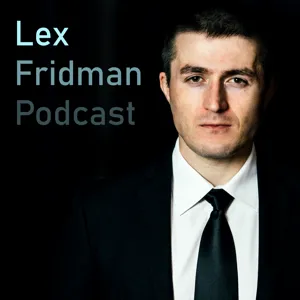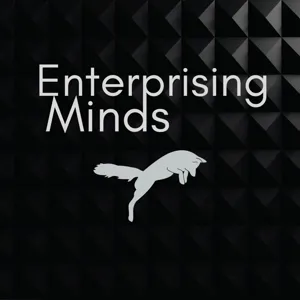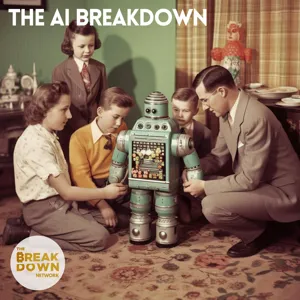Podcast Summary
From Farm to Humanoid Robots: Brett Adcock's Journey: Brett Adcock, from farming background to Figure AI, believes humanoid robots' potential to replace human labor in the largest industry could lead to an era of abundance and potentially impact AGI timeline.
Brett Adcock, the founder and CEO of Figure AI, has had an impressive career trajectory, transitioning from growing up on a farm in Illinois to coding, building software companies, and eventually starting Figure, a company focused on developing and delivering humanoid general purpose robots. Figure recently raised nearly $700 million in funding from major tech companies. Adcock's background in both software and hardware led him to start Archer Aviation, where he focused on building electric vertical takeoff and landing aircraft. However, the leap from Archer to Figure was less of a leap due to his belief in the immense potential of humanoid robots. The market for humanoid robots, which can do human-like work, is projected to be the largest industry in the world due to the vast amount of human labor involved. Adcock also believes that having robots do real work every day could lead to an age of abundance in terms of goods and services prices, and could potentially impact the timeline for artificial general intelligence.
The humanoid form is ideal for commercial automation: Humanoid robots can perform various tasks efficiently and cost-effectively due to their general interface and the world being optimized for humans.
Humanoid robots are the ideal form factor for commercial automation due to the world being built specifically for humans. The humanoid form allows for a general interface to automate various tasks and applications, making it more cost-effective and efficient compared to building specialized robots for each unique use case. The world was optimized for the average human, and a single humanoid robot can be amortized over millions of tasks, reducing the need for raising capital and building teams for each specialized robot. Although the robotics industry currently focuses on specialized robots, it may not be the most efficient approach for commercial automation.
Advancements in battery and motor power enable robotics company to prove capabilities: Robotics company demonstrates industrial autonomy and home manipulation, optimistic about future due to technological advancements in battery and motor power
The current decade presents an opportune time for building a robotics company due to advancements in technology, specifically in battery and motor power. The company has been able to prove its capabilities with an MVP and has conducted public demos in both industrial and home settings. In industrial solutions, they have demonstrated fully autonomous bin moving using bipedal robots. In the home market, they have shown end-to-end consumer level manipulation and speech to speech reasoning. The company is excited about the future as they have not yet reached any technical limitations and are pushing hard to find them. They have chosen to enter industrial solutions first to build the AI data engine faster and build manufacturing volumes quicker, while also exploring the home market due to its challenges and potential. The advancements in battery and motor power have made this possible, and the company is optimistic about the next 24 months as they continue to explore the boundaries of what's possible.
Advancements in technology have made robots more functional and practical: Improved battery technology, better locomotion controllers, and progress in AI systems have made robots more stable, efficient, and capable of understanding speech, enabling them to carry heavier loads, travel longer distances, and perform human-like work reliably.
The advancements in technology over the past two decades have made robots more functional and practical than ever before. The improvements in battery technology have increased the range and power of robots, making them capable of carrying heavier loads and traveling longer distances. The development of better locomotion controllers has made humanoid robots more stable and efficient, enabling them to walk and move more naturally. The progress in AI systems has made it possible for robots to understand and respond to speech, making speech the default user interface. Despite the challenges and risks involved, the team's aggressive optimism and determination to figure things out have driven them forward in their quest to deliver a commercial humanoid robot to the market. This is a groundbreaking achievement, as no one has been able to do it before, and it requires the robot to perform human-like work reliably and continuously over long periods.
Building a team for a complex robot project: Clearly defining mission, vision, and values, extensive recruitment efforts, and a critical roadmap are essential for building a team and creating a reliable and robust robot with over 30 degrees of freedom.
Building a team for a complex project like creating a robot with over 30 degrees of freedom involves setting a clear mission, vision, and values, and then building an org chart detailing the necessary teams and skill sets. However, finding the right people for these roles can be challenging, requiring extensive recruitment efforts such as cold calling and emailing potential candidates. The process is lengthy and requires a significant investment of time and resources. Additionally, the challenges of creating such a robot extend beyond team building, including the need for hardware innovations and robot learning. These challenges are ongoing and evolve as the project progresses, making the roadmap for the next 12 to 24 months critical for optimization. Ultimately, the goal is to create a reliable and robust robot, rather than focusing on new applications.
Building a strong team and creating a great product: Identifying necessary roles, recruiting right people, and developing shared vision leads to a team that can create incredible products and bring them to market. FIGURE focuses on reliable and safe robots, manufacturing at scale, and managing a fleet for impact in various industries.
Building a strong team and creating a great product are the foundation for entrepreneurial success. This involves identifying necessary roles, recruiting the right people, and working closely with them to develop a shared vision. It requires hard work, but the result is a team that can create an incredible product and bring it to market. In the context of FIGURE, this means developing reliable and safe robots that can perform useful tasks, manufacturing them at scale, and managing a fleet. The ultimate goal is to have robots working in various industries and making a significant impact. The challenges include ensuring reliability, safety, and manufacturing at scale, but these are not insurmountable obstacles. FIGURE's unique approach, which includes vertical integration and in-house manufacturing of actuators, sets it apart from many other organizations.
Designing and manufacturing in-house for advanced projects: In-house design and manufacturing for advanced projects comes with challenges, but an iterative approach focusing on continuous testing and updating can help manage the process effectively.
Building an advanced hardware and software project, like a humanoid robot company, often requires a combination of buying and building solutions. While the default is to buy, there are situations where no mature supply chain exists, and the only option is to design and manufacture in-house. This approach comes with significant challenges, including managing humans, maintaining complex systems, and dealing with the uncertainties of new technology. However, an iterative design approach, focusing on continuous testing and updating, can help manage the product development process effectively. Ultimately, the success of such a project depends on the ability to adapt and navigate the complexities of hardware and software development.
Robotics Design Process: Clear Requirements, Thorough Conceptualization, and Rigorous Testing: Robotics design process involves clear requirements, thorough conceptualization, rigorous testing, and multiple design gates for collaboration and safety checks.
The engineering design process for robotics is a meticulous and methodical endeavor, with a focus on setting clear requirements, thorough conceptualization, and rigorous testing. The process involves several design gates, or phases, where the entire company collaborates to ensure the design meets safety and functional needs. This is different from software development, where the process is faster but still follows a scientific method. In robotics engineering, decisions about design choices, such as power systems or actuator types, must be made objectively and with careful consideration of trade-offs and requirements. The design process is longer and more complex due to the physical nature of the product, requiring a more methodical and deliberate approach.
Hardware development vs software development: Different approaches: Successful hardware development requires iterative design, rapid prototyping, and effective partnerships for advanced capabilities.
The process of developing hardware, particularly robotics, involves a unique approach compared to software development. While software development relies on top-down planning, iterative design is crucial for hardware development due to its longer production timeline. The best hardware engineers possess a knack for rapid prototyping and iteration, allowing them to correct mistakes quickly and efficiently. One example of successful hardware development is the partnership between the speaker's company and BMW, where robots are being integrated into BMW's manufacturing facilities. The first facility, located in Spartanburg, South Carolina, produces approximately 1,400 cars daily and is the most productive globally. The company has identified the first five use cases for the robots and is actively working on implementing the first one. Another significant partnership is with OpenAI, focusing on implementing advanced language reasoning capabilities on the robot. OpenAI brings expertise in vision language models and a top-notch team, enabling the development of new AI models for the robots. The ultimate goal is to create a "two-part brain" for the robot, with a centralized brain that can be communicated with and a language reasoning component provided by OpenAI.
Developing Affordable Humanoid Robots for Household Chores: Figure is creating humanoid robots for household chores using AI to combine motor commands and language reasoning, with the goal of affordability and social acceptance.
Figure is developing AI systems to enable robots to perform complex tasks by combining low-level motor commanding with high-level language reasoning. This approach is essential for creating robots that can understand and respond to human commands, learn from past experiences, and perform tasks like household chores. Figure's ultimate goal is to create affordable humanoid robots that can replace human labor in the home. These robots will be capable of doing physical work, such as cooking, cleaning, and doing laundry. Cost reduction is a priority, and as manufacturing volumes increase, the cost of robots is expected to decrease significantly. Despite initial concerns about the expense of robots, Figure is working on cost reduction strategies and believes that robots will eventually become an affordable option for households. Social acceptance of robots is an ongoing concern, but Figure is confident that as robots become more common and affordable, they will become integrated into daily life.
Building trust and safety records for humanoid robots: Integrating robots into our world requires addressing social acceptance. Humanoid robots may serve as 'actuators' for AGI, but ensuring their safety and capability for real work before AGI arrives could prevent a dystopian future.
Integrating robots into our world requires addressing the issue of social acceptance. This involves building trust and safety records gradually, as seen in the automotive industry. The fear of potential negative outcomes, such as those depicted in science fiction, adds to the challenge. AGI may come before humanoid robots, but ensuring humanoids are safe and capable of doing real work before AGI arrives could prevent a dystopian future where AGI forces humans to do its bidding. The humanoid robots could serve as the "actuators" for AGI, performing tasks and allowing AGI to focus on more complex tasks. It's crucial to consider social acceptance and safety concerns from the beginning to create a positive future for human-robot interaction.
Incorporating real-world info from robots could advance AGI within 5-10 years: The FIGR team believes real-world data from robots could be a game-changer for AGI research, but it's still a work in progress
Large language models currently face significant challenges when it comes to reasoning about the physical world and planning actions. The team at FIGR believes that incorporating real-world information from robots could be a game-changer in achieving Artificial General Intelligence (AGI) within the next 5-10 years. However, this is still a work in progress, and the outcome remains uncertain. The team is optimistic about their role in advancing AGI research and encourages listeners to follow their progress on various platforms, including Twitter (@nopriorspod), YouTube, Apple Podcasts, Spotify, and their website (nodashpriors.com), where they release new episodes weekly and provide transcripts.






